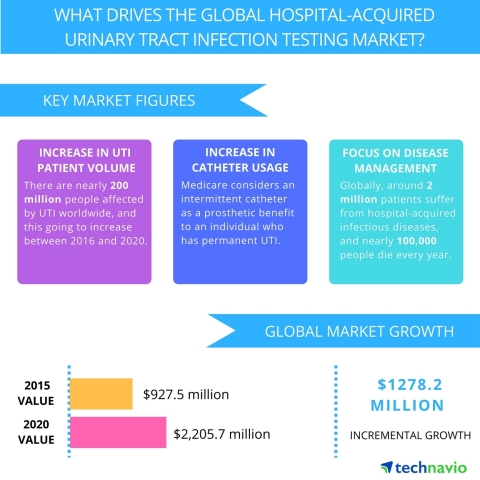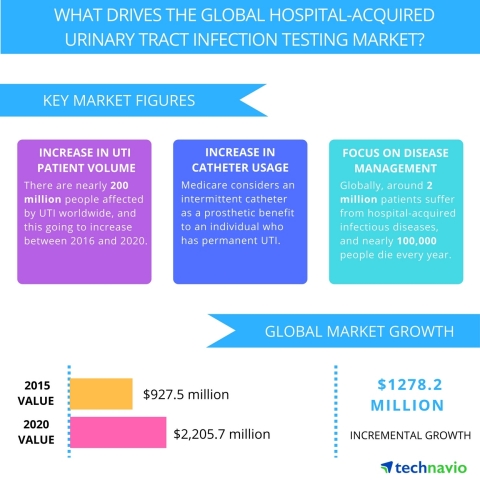LONDON--(BUSINESS WIRE)--Technavio analysts forecast the global hospital-acquired urinary tract infection testing market to grow at a CAGR of around 19% during the forecast period, according to their latest report.
The research study covers the present scenario and growth prospects of the global hospital-acquired urinary tract infection testing market for 2016-2020. The report lists hospitals and outpatient's department and diagnostics laboratories, as the two major end-user segments. The hospitals and outpatient's department accounted for over 75% of the market share in 2015.
According to Srinivas Sashidhar, a lead analyst at Technavio for in-vitro diagnostics research, “The global hospital-acquired UTI testing market is expected to grow at a significant rate due to the adoption of measures, to control and prevent infection.”
Request a sample report: http://www.technavio.com/request-a-sample?report=54827
Technavio’s sample reports are free of charge and contain multiple sections of the report including the market size and forecast, drivers, challenges, trends, and more.
Technavio healthcare and life sciences analysts highlight the following three factors that are contributing to the growth of the global hospital-acquired urinary tract infection testing market:
- Use of catheter increases leads to prevalence of hospital-acquired UTI
- Focus on disease management
- Technological advances increase adoption rate of testing devices
Use of catheter leads to increased prevalence of hospital-acquired UTI
Urinary incontinence is a common symptom resulting for disorders such as Parkinson’s disease, multiple sclerosis, dementia, and old age. There are nearly 200 million people affected by urinary incontinence worldwide, and this number is going to increase during the forecast period.
Catheters can help patients manage urinary incontinence, especially when surgery, medications, and behavioral treatment fail to provide relief. However, a catheter can pick up bacteria from the urethra and give them an easy route to enter the bladder, which causes infection. Thus, the use of urinary catheters is one of the causes for hospital-acquired UTI. However, since the use of catheters cannot be avoided, it mandates monitoring regular testing for UTI’s to identify the infection in the early stages.
Focus on disease management
Public and private policymakers and health insurance organizations are constantly examining and presenting disease management programs to reduce the number of hospital-acquired infection (HAIs) and indirect medical costs related to them. Globally, around 2 million patients suffer from hospital-acquired infectious diseases, and nearly 100,000 people die every year.
Disease management through regular patient monitoring plays a vital role in the prevention and treatment of hospital-acquired infectious diseases. Lack of proper monitoring in patients leads to relapse of the disease or readmission of the patient and increased length of hospital stay. Therefore, testing for hospital-acquired UTI infections is important in reducing readmission rates and improving the quality of patient care in a cost-effective manner.
Technological advances increase adoption rate of testing devices
Advances in the field of molecular diagnostics have enabled the detection and treatment of many diseases including HAIs. The continuous innovation in technology increases the performance and speed of molecular diagnostics and plays an integral part in identifying a disease and assessing a course of treatment.
The market is likely to witness more product launches with advanced features during the forecast period. Vendors are focusing on introducing innovative testing kits for the rapid detection of various microbes.
“POC testing has also gained importance across the world, and rapid diagnosis through POC devices helps in achieving the long-term goals of reducing in-patient HAIs and overall healthcare expenditure,” says Srinivas.
Browse Related Reports:
- Global Urinary Catheters Market 2016-2020
- Global Hospital Infection Therapeutics Market 2015-2019
- Global Urinary Incontinence Products Market 2015-2019
Do you need a report on a market in a specific geographical cluster or country but can’t find what you’re looking for? Don’t worry, Technavio also takes client requests. Please contact enquiry@technavio.com with your requirements and our analysts will be happy to create a customized report just for you.
About Technavio
Technavio is a leading global technology research and advisory company. The company develops over 2000 pieces of research every year, covering more than 500 technologies across 80 countries. Technavio has about 300 analysts globally who specialize in customized consulting and business research assignments across the latest leading edge technologies.
Technavio analysts employ primary as well as secondary research techniques to ascertain the size and vendor landscape in a range of markets. Analysts obtain information using a combination of bottom-up and top-down approaches, besides using in-house market modeling tools and proprietary databases. They corroborate this data with the data obtained from various market participants and stakeholders across the value chain, including vendors, service providers, distributors, re-sellers, and end-users.
If you are interested in more information, please contact our media team at media@technavio.com.




